Contrasting Activation Synthesis Hypothesis and Neurocognitive Hypothesis
VerifiedAdded on 2023/01/06
|8
|2623
|99
AI Summary
This study critically contrasts the activation synthesis hypothesis and the neurocognitive hypothesis in relation to dreaming. It explores the differences between these two theories and their explanations for the occurrence of dreams.
Contribute Materials
Your contribution can guide someone’s learning journey. Share your
documents today.
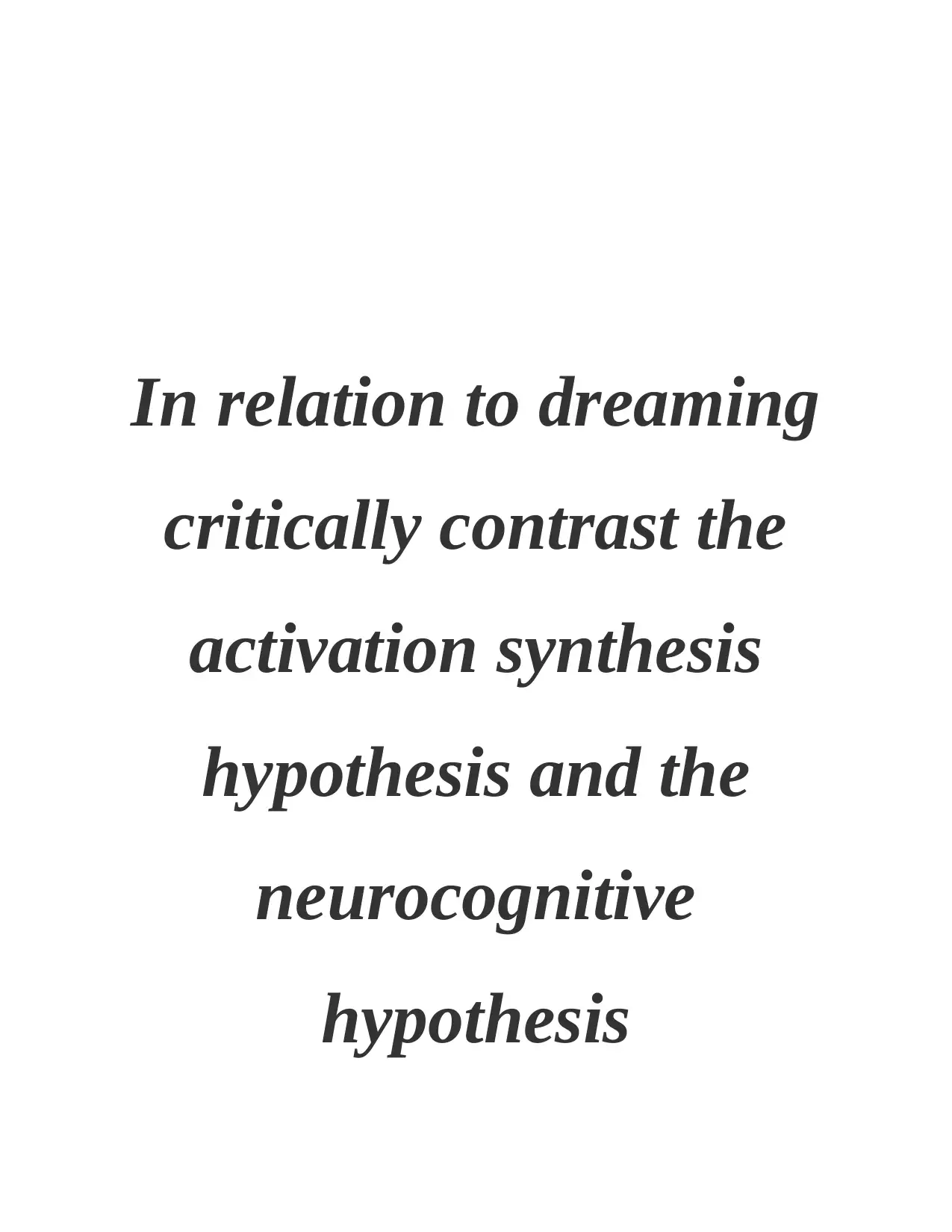
In relation to dreaming
critically contrast the
activation synthesis
hypothesis and the
neurocognitive
hypothesis
critically contrast the
activation synthesis
hypothesis and the
neurocognitive
hypothesis
Secure Best Marks with AI Grader
Need help grading? Try our AI Grader for instant feedback on your assignments.
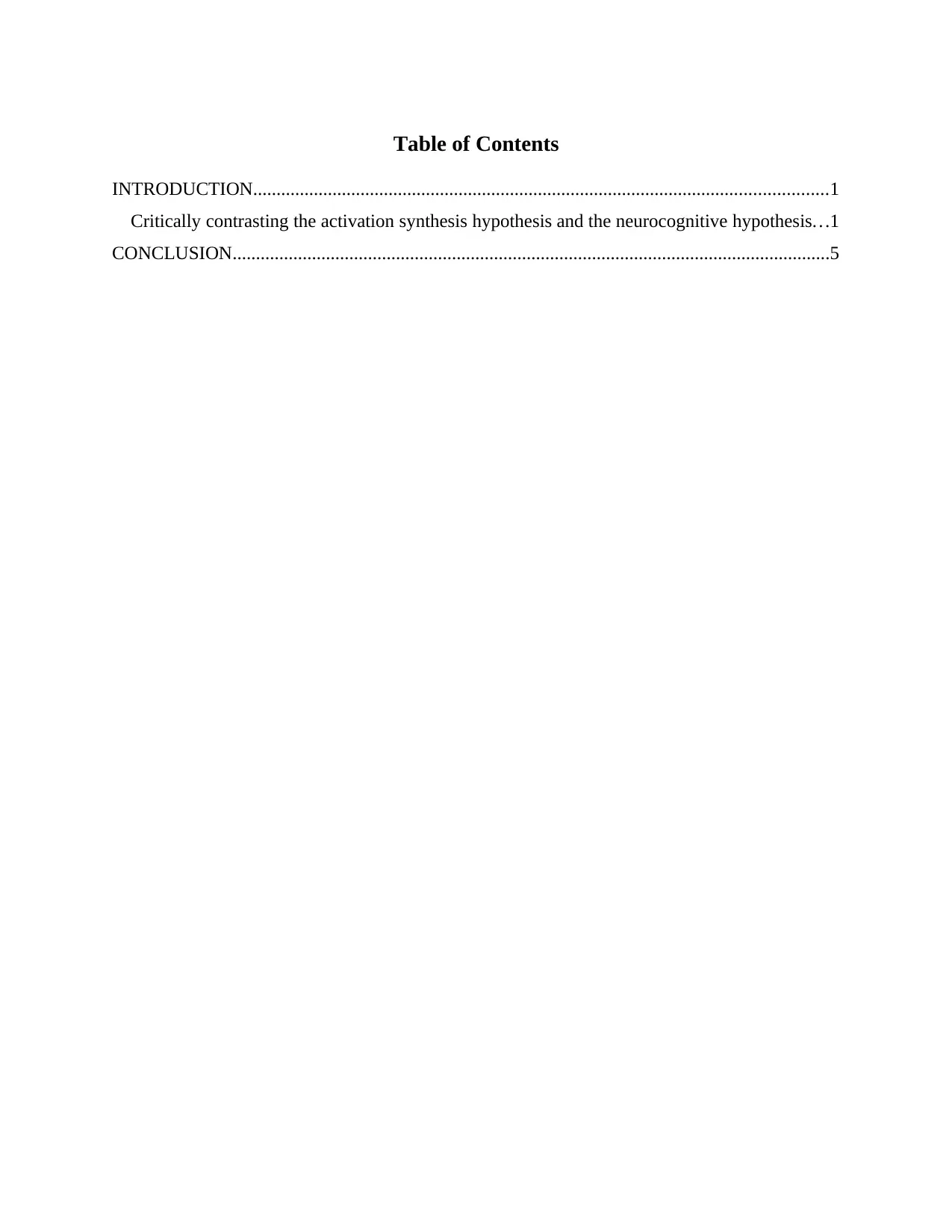
Table of Contents
INTRODUCTION...........................................................................................................................1
Critically contrasting the activation synthesis hypothesis and the neurocognitive hypothesis...1
CONCLUSION................................................................................................................................5
INTRODUCTION...........................................................................................................................1
Critically contrasting the activation synthesis hypothesis and the neurocognitive hypothesis...1
CONCLUSION................................................................................................................................5
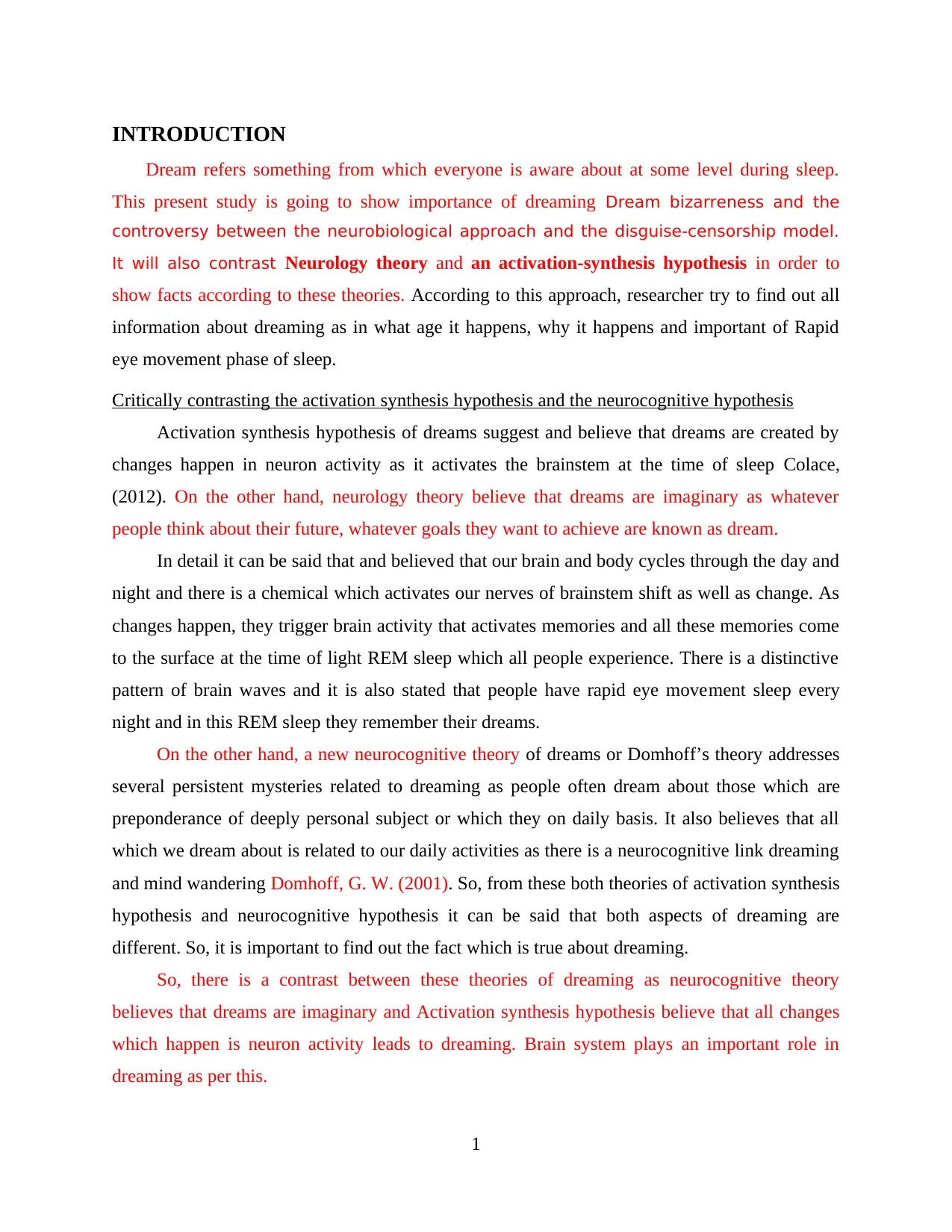
INTRODUCTION
Dream refers something from which everyone is aware about at some level during sleep.
This present study is going to show importance of dreaming Dream bizarreness and the
controversy between the neurobiological approach and the disguise-censorship model.
It will also contrast Neurology theory and an activation-synthesis hypothesis in order to
show facts according to these theories. According to this approach, researcher try to find out all
information about dreaming as in what age it happens, why it happens and important of Rapid
eye movement phase of sleep.
Critically contrasting the activation synthesis hypothesis and the neurocognitive hypothesis
Activation synthesis hypothesis of dreams suggest and believe that dreams are created by
changes happen in neuron activity as it activates the brainstem at the time of sleep Colace,
(2012). On the other hand, neurology theory believe that dreams are imaginary as whatever
people think about their future, whatever goals they want to achieve are known as dream.
In detail it can be said that and believed that our brain and body cycles through the day and
night and there is a chemical which activates our nerves of brainstem shift as well as change. As
changes happen, they trigger brain activity that activates memories and all these memories come
to the surface at the time of light REM sleep which all people experience. There is a distinctive
pattern of brain waves and it is also stated that people have rapid eye movement sleep every
night and in this REM sleep they remember their dreams.
On the other hand, a new neurocognitive theory of dreams or Domhoff’s theory addresses
several persistent mysteries related to dreaming as people often dream about those which are
preponderance of deeply personal subject or which they on daily basis. It also believes that all
which we dream about is related to our daily activities as there is a neurocognitive link dreaming
and mind wandering Domhoff, G. W. (2001). So, from these both theories of activation synthesis
hypothesis and neurocognitive hypothesis it can be said that both aspects of dreaming are
different. So, it is important to find out the fact which is true about dreaming.
So, there is a contrast between these theories of dreaming as neurocognitive theory
believes that dreams are imaginary and Activation synthesis hypothesis believe that all changes
which happen is neuron activity leads to dreaming. Brain system plays an important role in
dreaming as per this.
1
Dream refers something from which everyone is aware about at some level during sleep.
This present study is going to show importance of dreaming Dream bizarreness and the
controversy between the neurobiological approach and the disguise-censorship model.
It will also contrast Neurology theory and an activation-synthesis hypothesis in order to
show facts according to these theories. According to this approach, researcher try to find out all
information about dreaming as in what age it happens, why it happens and important of Rapid
eye movement phase of sleep.
Critically contrasting the activation synthesis hypothesis and the neurocognitive hypothesis
Activation synthesis hypothesis of dreams suggest and believe that dreams are created by
changes happen in neuron activity as it activates the brainstem at the time of sleep Colace,
(2012). On the other hand, neurology theory believe that dreams are imaginary as whatever
people think about their future, whatever goals they want to achieve are known as dream.
In detail it can be said that and believed that our brain and body cycles through the day and
night and there is a chemical which activates our nerves of brainstem shift as well as change. As
changes happen, they trigger brain activity that activates memories and all these memories come
to the surface at the time of light REM sleep which all people experience. There is a distinctive
pattern of brain waves and it is also stated that people have rapid eye movement sleep every
night and in this REM sleep they remember their dreams.
On the other hand, a new neurocognitive theory of dreams or Domhoff’s theory addresses
several persistent mysteries related to dreaming as people often dream about those which are
preponderance of deeply personal subject or which they on daily basis. It also believes that all
which we dream about is related to our daily activities as there is a neurocognitive link dreaming
and mind wandering Domhoff, G. W. (2001). So, from these both theories of activation synthesis
hypothesis and neurocognitive hypothesis it can be said that both aspects of dreaming are
different. So, it is important to find out the fact which is true about dreaming.
So, there is a contrast between these theories of dreaming as neurocognitive theory
believes that dreams are imaginary and Activation synthesis hypothesis believe that all changes
which happen is neuron activity leads to dreaming. Brain system plays an important role in
dreaming as per this.
1
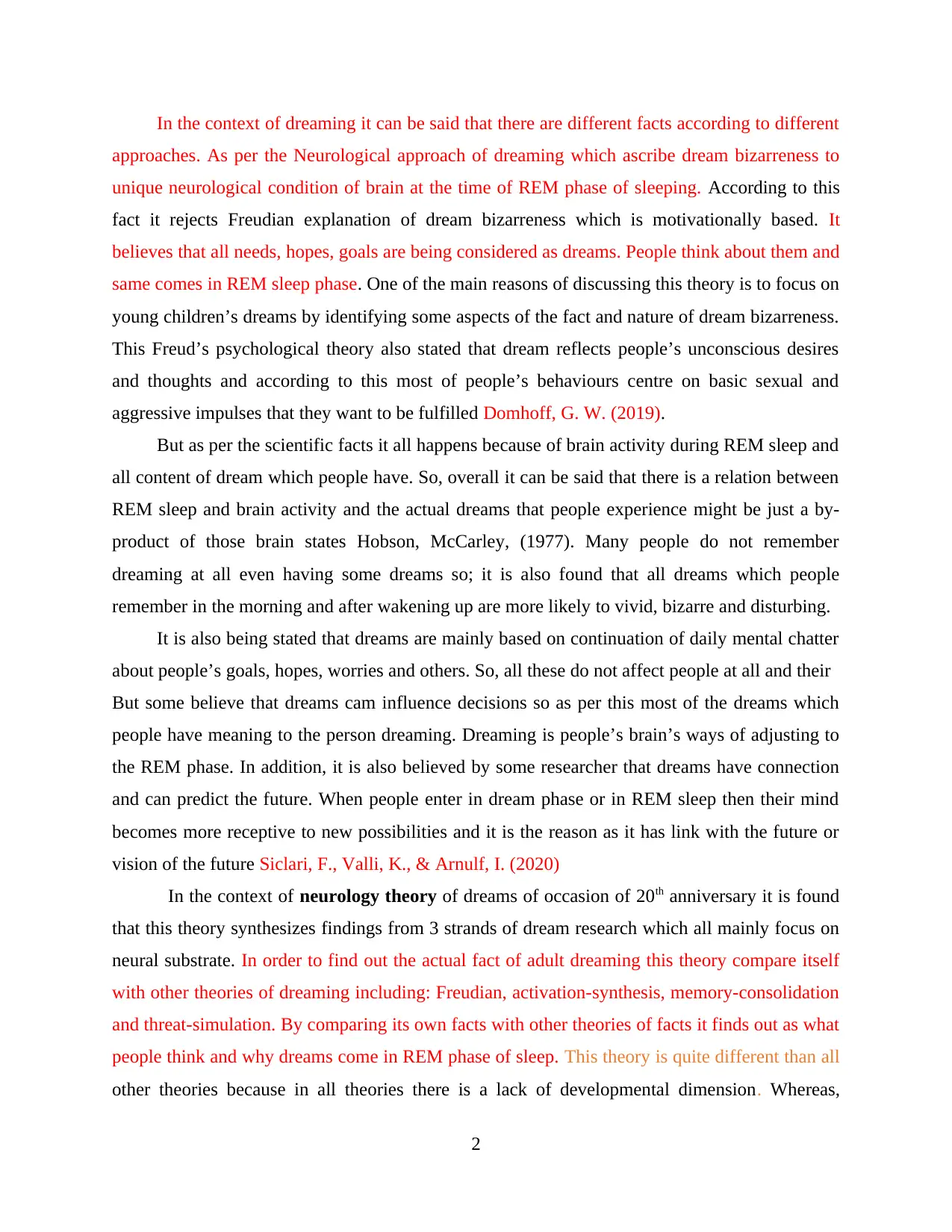
In the context of dreaming it can be said that there are different facts according to different
approaches. As per the Neurological approach of dreaming which ascribe dream bizarreness to
unique neurological condition of brain at the time of REM phase of sleeping. According to this
fact it rejects Freudian explanation of dream bizarreness which is motivationally based. It
believes that all needs, hopes, goals are being considered as dreams. People think about them and
same comes in REM sleep phase. One of the main reasons of discussing this theory is to focus on
young children’s dreams by identifying some aspects of the fact and nature of dream bizarreness.
This Freud’s psychological theory also stated that dream reflects people’s unconscious desires
and thoughts and according to this most of people’s behaviours centre on basic sexual and
aggressive impulses that they want to be fulfilled Domhoff, G. W. (2019).
But as per the scientific facts it all happens because of brain activity during REM sleep and
all content of dream which people have. So, overall it can be said that there is a relation between
REM sleep and brain activity and the actual dreams that people experience might be just a by-
product of those brain states Hobson, McCarley, (1977). Many people do not remember
dreaming at all even having some dreams so; it is also found that all dreams which people
remember in the morning and after wakening up are more likely to vivid, bizarre and disturbing.
It is also being stated that dreams are mainly based on continuation of daily mental chatter
about people’s goals, hopes, worries and others. So, all these do not affect people at all and their
But some believe that dreams cam influence decisions so as per this most of the dreams which
people have meaning to the person dreaming. Dreaming is people’s brain’s ways of adjusting to
the REM phase. In addition, it is also believed by some researcher that dreams have connection
and can predict the future. When people enter in dream phase or in REM sleep then their mind
becomes more receptive to new possibilities and it is the reason as it has link with the future or
vision of the future Siclari, F., Valli, K., & Arnulf, I. (2020)
In the context of neurology theory of dreams of occasion of 20th anniversary it is found
that this theory synthesizes findings from 3 strands of dream research which all mainly focus on
neural substrate. In order to find out the actual fact of adult dreaming this theory compare itself
with other theories of dreaming including: Freudian, activation-synthesis, memory-consolidation
and threat-simulation. By comparing its own facts with other theories of facts it finds out as what
people think and why dreams come in REM phase of sleep. This theory is quite different than all
other theories because in all theories there is a lack of developmental dimension. Whereas,
2
approaches. As per the Neurological approach of dreaming which ascribe dream bizarreness to
unique neurological condition of brain at the time of REM phase of sleeping. According to this
fact it rejects Freudian explanation of dream bizarreness which is motivationally based. It
believes that all needs, hopes, goals are being considered as dreams. People think about them and
same comes in REM sleep phase. One of the main reasons of discussing this theory is to focus on
young children’s dreams by identifying some aspects of the fact and nature of dream bizarreness.
This Freud’s psychological theory also stated that dream reflects people’s unconscious desires
and thoughts and according to this most of people’s behaviours centre on basic sexual and
aggressive impulses that they want to be fulfilled Domhoff, G. W. (2019).
But as per the scientific facts it all happens because of brain activity during REM sleep and
all content of dream which people have. So, overall it can be said that there is a relation between
REM sleep and brain activity and the actual dreams that people experience might be just a by-
product of those brain states Hobson, McCarley, (1977). Many people do not remember
dreaming at all even having some dreams so; it is also found that all dreams which people
remember in the morning and after wakening up are more likely to vivid, bizarre and disturbing.
It is also being stated that dreams are mainly based on continuation of daily mental chatter
about people’s goals, hopes, worries and others. So, all these do not affect people at all and their
But some believe that dreams cam influence decisions so as per this most of the dreams which
people have meaning to the person dreaming. Dreaming is people’s brain’s ways of adjusting to
the REM phase. In addition, it is also believed by some researcher that dreams have connection
and can predict the future. When people enter in dream phase or in REM sleep then their mind
becomes more receptive to new possibilities and it is the reason as it has link with the future or
vision of the future Siclari, F., Valli, K., & Arnulf, I. (2020)
In the context of neurology theory of dreams of occasion of 20th anniversary it is found
that this theory synthesizes findings from 3 strands of dream research which all mainly focus on
neural substrate. In order to find out the actual fact of adult dreaming this theory compare itself
with other theories of dreaming including: Freudian, activation-synthesis, memory-consolidation
and threat-simulation. By comparing its own facts with other theories of facts it finds out as what
people think and why dreams come in REM phase of sleep. This theory is quite different than all
other theories because in all theories there is a lack of developmental dimension. Whereas,
2
Secure Best Marks with AI Grader
Need help grading? Try our AI Grader for instant feedback on your assignments.
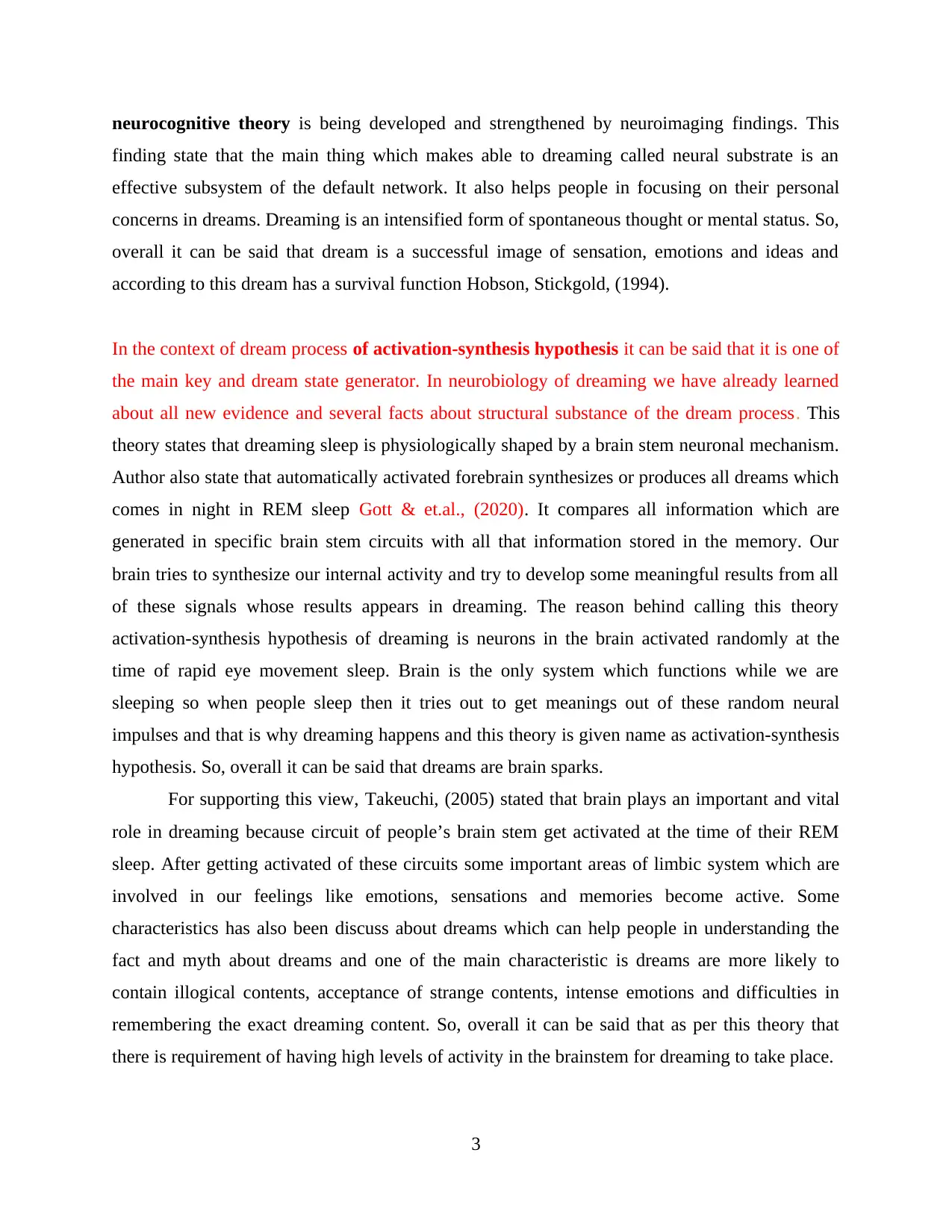
neurocognitive theory is being developed and strengthened by neuroimaging findings. This
finding state that the main thing which makes able to dreaming called neural substrate is an
effective subsystem of the default network. It also helps people in focusing on their personal
concerns in dreams. Dreaming is an intensified form of spontaneous thought or mental status. So,
overall it can be said that dream is a successful image of sensation, emotions and ideas and
according to this dream has a survival function Hobson, Stickgold, (1994).
In the context of dream process of activation-synthesis hypothesis it can be said that it is one of
the main key and dream state generator. In neurobiology of dreaming we have already learned
about all new evidence and several facts about structural substance of the dream process. This
theory states that dreaming sleep is physiologically shaped by a brain stem neuronal mechanism.
Author also state that automatically activated forebrain synthesizes or produces all dreams which
comes in night in REM sleep Gott & et.al., (2020). It compares all information which are
generated in specific brain stem circuits with all that information stored in the memory. Our
brain tries to synthesize our internal activity and try to develop some meaningful results from all
of these signals whose results appears in dreaming. The reason behind calling this theory
activation-synthesis hypothesis of dreaming is neurons in the brain activated randomly at the
time of rapid eye movement sleep. Brain is the only system which functions while we are
sleeping so when people sleep then it tries out to get meanings out of these random neural
impulses and that is why dreaming happens and this theory is given name as activation-synthesis
hypothesis. So, overall it can be said that dreams are brain sparks.
For supporting this view, Takeuchi, (2005) stated that brain plays an important and vital
role in dreaming because circuit of people’s brain stem get activated at the time of their REM
sleep. After getting activated of these circuits some important areas of limbic system which are
involved in our feelings like emotions, sensations and memories become active. Some
characteristics has also been discuss about dreams which can help people in understanding the
fact and myth about dreams and one of the main characteristic is dreams are more likely to
contain illogical contents, acceptance of strange contents, intense emotions and difficulties in
remembering the exact dreaming content. So, overall it can be said that as per this theory that
there is requirement of having high levels of activity in the brainstem for dreaming to take place.
3
finding state that the main thing which makes able to dreaming called neural substrate is an
effective subsystem of the default network. It also helps people in focusing on their personal
concerns in dreams. Dreaming is an intensified form of spontaneous thought or mental status. So,
overall it can be said that dream is a successful image of sensation, emotions and ideas and
according to this dream has a survival function Hobson, Stickgold, (1994).
In the context of dream process of activation-synthesis hypothesis it can be said that it is one of
the main key and dream state generator. In neurobiology of dreaming we have already learned
about all new evidence and several facts about structural substance of the dream process. This
theory states that dreaming sleep is physiologically shaped by a brain stem neuronal mechanism.
Author also state that automatically activated forebrain synthesizes or produces all dreams which
comes in night in REM sleep Gott & et.al., (2020). It compares all information which are
generated in specific brain stem circuits with all that information stored in the memory. Our
brain tries to synthesize our internal activity and try to develop some meaningful results from all
of these signals whose results appears in dreaming. The reason behind calling this theory
activation-synthesis hypothesis of dreaming is neurons in the brain activated randomly at the
time of rapid eye movement sleep. Brain is the only system which functions while we are
sleeping so when people sleep then it tries out to get meanings out of these random neural
impulses and that is why dreaming happens and this theory is given name as activation-synthesis
hypothesis. So, overall it can be said that dreams are brain sparks.
For supporting this view, Takeuchi, (2005) stated that brain plays an important and vital
role in dreaming because circuit of people’s brain stem get activated at the time of their REM
sleep. After getting activated of these circuits some important areas of limbic system which are
involved in our feelings like emotions, sensations and memories become active. Some
characteristics has also been discuss about dreams which can help people in understanding the
fact and myth about dreams and one of the main characteristic is dreams are more likely to
contain illogical contents, acceptance of strange contents, intense emotions and difficulties in
remembering the exact dreaming content. So, overall it can be said that as per this theory that
there is requirement of having high levels of activity in the brainstem for dreaming to take place.
3
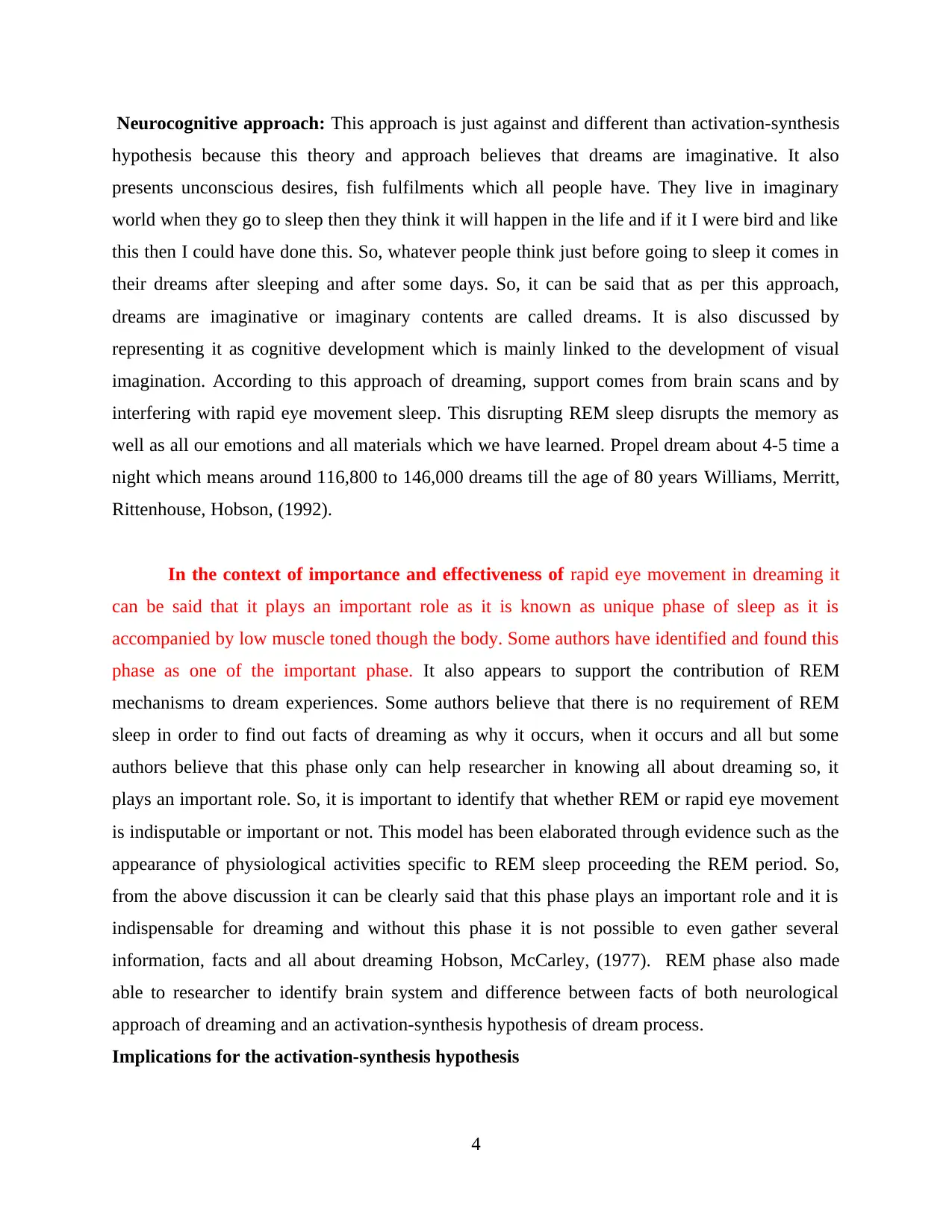
Neurocognitive approach: This approach is just against and different than activation-synthesis
hypothesis because this theory and approach believes that dreams are imaginative. It also
presents unconscious desires, fish fulfilments which all people have. They live in imaginary
world when they go to sleep then they think it will happen in the life and if it I were bird and like
this then I could have done this. So, whatever people think just before going to sleep it comes in
their dreams after sleeping and after some days. So, it can be said that as per this approach,
dreams are imaginative or imaginary contents are called dreams. It is also discussed by
representing it as cognitive development which is mainly linked to the development of visual
imagination. According to this approach of dreaming, support comes from brain scans and by
interfering with rapid eye movement sleep. This disrupting REM sleep disrupts the memory as
well as all our emotions and all materials which we have learned. Propel dream about 4-5 time a
night which means around 116,800 to 146,000 dreams till the age of 80 years Williams, Merritt,
Rittenhouse, Hobson, (1992).
In the context of importance and effectiveness of rapid eye movement in dreaming it
can be said that it plays an important role as it is known as unique phase of sleep as it is
accompanied by low muscle toned though the body. Some authors have identified and found this
phase as one of the important phase. It also appears to support the contribution of REM
mechanisms to dream experiences. Some authors believe that there is no requirement of REM
sleep in order to find out facts of dreaming as why it occurs, when it occurs and all but some
authors believe that this phase only can help researcher in knowing all about dreaming so, it
plays an important role. So, it is important to identify that whether REM or rapid eye movement
is indisputable or important or not. This model has been elaborated through evidence such as the
appearance of physiological activities specific to REM sleep proceeding the REM period. So,
from the above discussion it can be clearly said that this phase plays an important role and it is
indispensable for dreaming and without this phase it is not possible to even gather several
information, facts and all about dreaming Hobson, McCarley, (1977). REM phase also made
able to researcher to identify brain system and difference between facts of both neurological
approach of dreaming and an activation-synthesis hypothesis of dream process.
Implications for the activation-synthesis hypothesis
4
hypothesis because this theory and approach believes that dreams are imaginative. It also
presents unconscious desires, fish fulfilments which all people have. They live in imaginary
world when they go to sleep then they think it will happen in the life and if it I were bird and like
this then I could have done this. So, whatever people think just before going to sleep it comes in
their dreams after sleeping and after some days. So, it can be said that as per this approach,
dreams are imaginative or imaginary contents are called dreams. It is also discussed by
representing it as cognitive development which is mainly linked to the development of visual
imagination. According to this approach of dreaming, support comes from brain scans and by
interfering with rapid eye movement sleep. This disrupting REM sleep disrupts the memory as
well as all our emotions and all materials which we have learned. Propel dream about 4-5 time a
night which means around 116,800 to 146,000 dreams till the age of 80 years Williams, Merritt,
Rittenhouse, Hobson, (1992).
In the context of importance and effectiveness of rapid eye movement in dreaming it
can be said that it plays an important role as it is known as unique phase of sleep as it is
accompanied by low muscle toned though the body. Some authors have identified and found this
phase as one of the important phase. It also appears to support the contribution of REM
mechanisms to dream experiences. Some authors believe that there is no requirement of REM
sleep in order to find out facts of dreaming as why it occurs, when it occurs and all but some
authors believe that this phase only can help researcher in knowing all about dreaming so, it
plays an important role. So, it is important to identify that whether REM or rapid eye movement
is indisputable or important or not. This model has been elaborated through evidence such as the
appearance of physiological activities specific to REM sleep proceeding the REM period. So,
from the above discussion it can be clearly said that this phase plays an important role and it is
indispensable for dreaming and without this phase it is not possible to even gather several
information, facts and all about dreaming Hobson, McCarley, (1977). REM phase also made
able to researcher to identify brain system and difference between facts of both neurological
approach of dreaming and an activation-synthesis hypothesis of dream process.
Implications for the activation-synthesis hypothesis
4
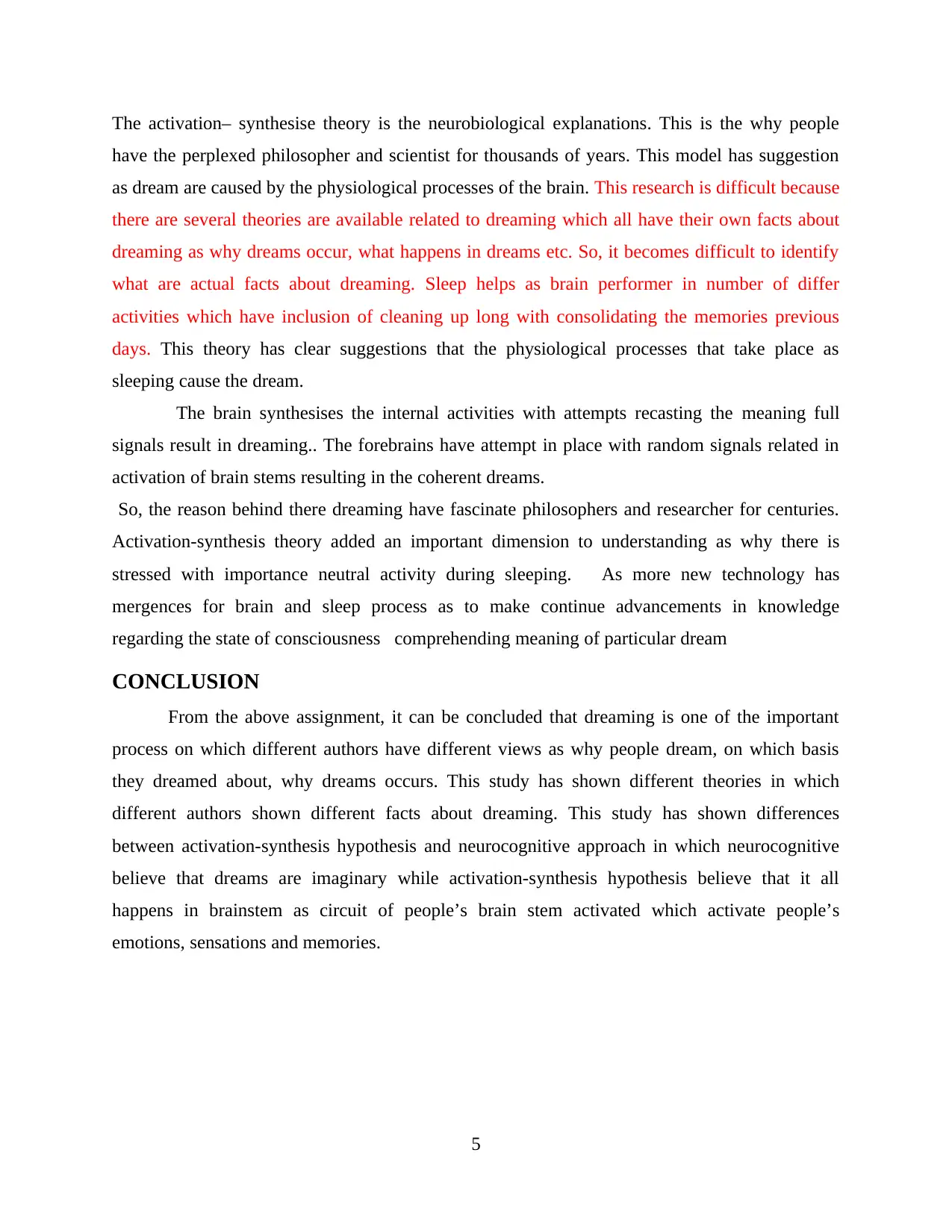
The activation– synthesise theory is the neurobiological explanations. This is the why people
have the perplexed philosopher and scientist for thousands of years. This model has suggestion
as dream are caused by the physiological processes of the brain. This research is difficult because
there are several theories are available related to dreaming which all have their own facts about
dreaming as why dreams occur, what happens in dreams etc. So, it becomes difficult to identify
what are actual facts about dreaming. Sleep helps as brain performer in number of differ
activities which have inclusion of cleaning up long with consolidating the memories previous
days. This theory has clear suggestions that the physiological processes that take place as
sleeping cause the dream.
The brain synthesises the internal activities with attempts recasting the meaning full
signals result in dreaming.. The forebrains have attempt in place with random signals related in
activation of brain stems resulting in the coherent dreams.
So, the reason behind there dreaming have fascinate philosophers and researcher for centuries.
Activation-synthesis theory added an important dimension to understanding as why there is
stressed with importance neutral activity during sleeping. As more new technology has
mergences for brain and sleep process as to make continue advancements in knowledge
regarding the state of consciousness comprehending meaning of particular dream
CONCLUSION
From the above assignment, it can be concluded that dreaming is one of the important
process on which different authors have different views as why people dream, on which basis
they dreamed about, why dreams occurs. This study has shown different theories in which
different authors shown different facts about dreaming. This study has shown differences
between activation-synthesis hypothesis and neurocognitive approach in which neurocognitive
believe that dreams are imaginary while activation-synthesis hypothesis believe that it all
happens in brainstem as circuit of people’s brain stem activated which activate people’s
emotions, sensations and memories.
5
have the perplexed philosopher and scientist for thousands of years. This model has suggestion
as dream are caused by the physiological processes of the brain. This research is difficult because
there are several theories are available related to dreaming which all have their own facts about
dreaming as why dreams occur, what happens in dreams etc. So, it becomes difficult to identify
what are actual facts about dreaming. Sleep helps as brain performer in number of differ
activities which have inclusion of cleaning up long with consolidating the memories previous
days. This theory has clear suggestions that the physiological processes that take place as
sleeping cause the dream.
The brain synthesises the internal activities with attempts recasting the meaning full
signals result in dreaming.. The forebrains have attempt in place with random signals related in
activation of brain stems resulting in the coherent dreams.
So, the reason behind there dreaming have fascinate philosophers and researcher for centuries.
Activation-synthesis theory added an important dimension to understanding as why there is
stressed with importance neutral activity during sleeping. As more new technology has
mergences for brain and sleep process as to make continue advancements in knowledge
regarding the state of consciousness comprehending meaning of particular dream
CONCLUSION
From the above assignment, it can be concluded that dreaming is one of the important
process on which different authors have different views as why people dream, on which basis
they dreamed about, why dreams occurs. This study has shown different theories in which
different authors shown different facts about dreaming. This study has shown differences
between activation-synthesis hypothesis and neurocognitive approach in which neurocognitive
believe that dreams are imaginary while activation-synthesis hypothesis believe that it all
happens in brainstem as circuit of people’s brain stem activated which activate people’s
emotions, sensations and memories.
5
Paraphrase This Document
Need a fresh take? Get an instant paraphrase of this document with our AI Paraphraser
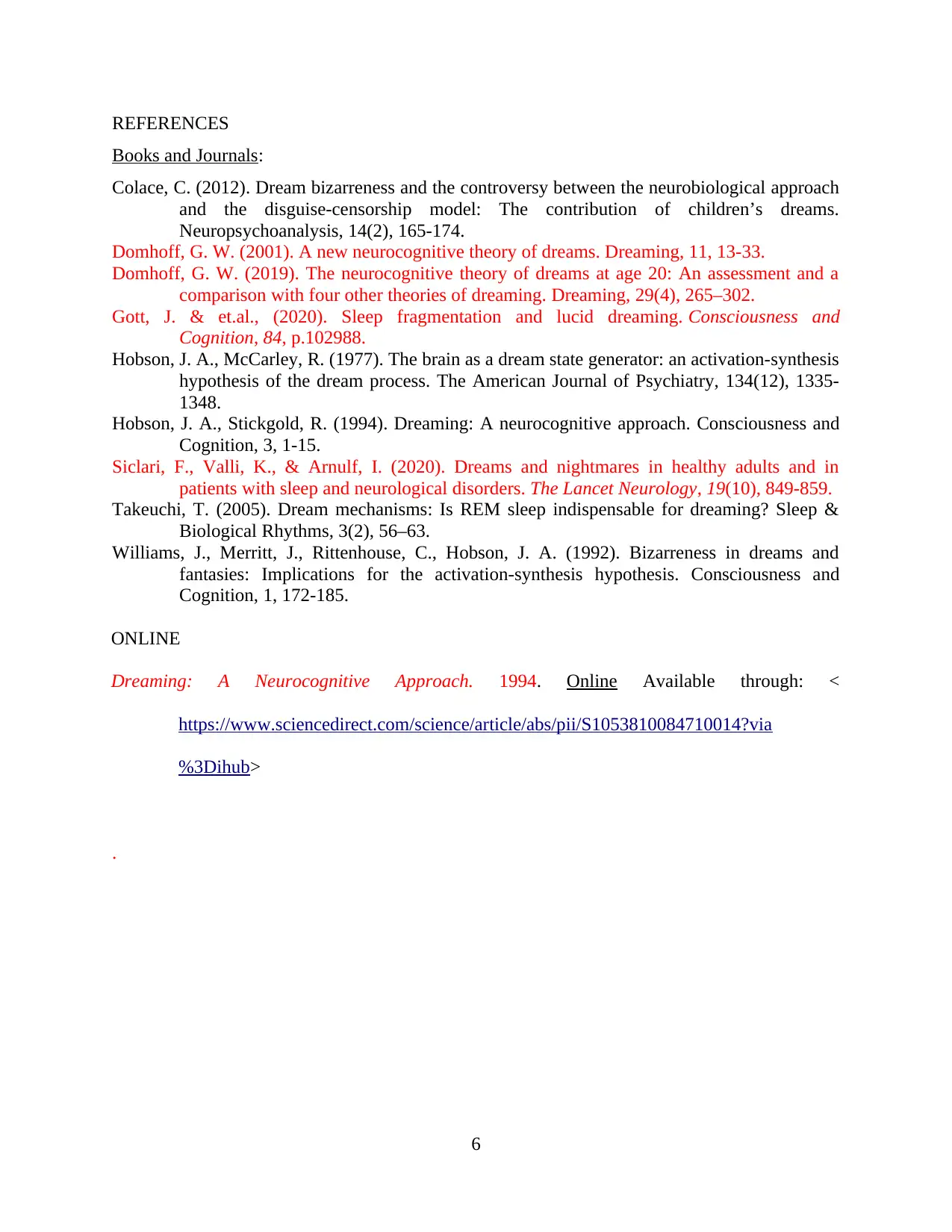
REFERENCES
Books and Journals:
Colace, C. (2012). Dream bizarreness and the controversy between the neurobiological approach
and the disguise-censorship model: The contribution of children’s dreams.
Neuropsychoanalysis, 14(2), 165-174.
Domhoff, G. W. (2001). A new neurocognitive theory of dreams. Dreaming, 11, 13-33.
Domhoff, G. W. (2019). The neurocognitive theory of dreams at age 20: An assessment and a
comparison with four other theories of dreaming. Dreaming, 29(4), 265–302.
Gott, J. & et.al., (2020). Sleep fragmentation and lucid dreaming. Consciousness and
Cognition, 84, p.102988.
Hobson, J. A., McCarley, R. (1977). The brain as a dream state generator: an activation-synthesis
hypothesis of the dream process. The American Journal of Psychiatry, 134(12), 1335-
1348.
Hobson, J. A., Stickgold, R. (1994). Dreaming: A neurocognitive approach. Consciousness and
Cognition, 3, 1-15.
Siclari, F., Valli, K., & Arnulf, I. (2020). Dreams and nightmares in healthy adults and in
patients with sleep and neurological disorders. The Lancet Neurology, 19(10), 849-859.
Takeuchi, T. (2005). Dream mechanisms: Is REM sleep indispensable for dreaming? Sleep &
Biological Rhythms, 3(2), 56–63.
Williams, J., Merritt, J., Rittenhouse, C., Hobson, J. A. (1992). Bizarreness in dreams and
fantasies: Implications for the activation-synthesis hypothesis. Consciousness and
Cognition, 1, 172-185.
ONLINE
Dreaming: A Neurocognitive Approach. 1994. Online Available through: <
https://www.sciencedirect.com/science/article/abs/pii/S1053810084710014?via
%3Dihub>
.
6
Books and Journals:
Colace, C. (2012). Dream bizarreness and the controversy between the neurobiological approach
and the disguise-censorship model: The contribution of children’s dreams.
Neuropsychoanalysis, 14(2), 165-174.
Domhoff, G. W. (2001). A new neurocognitive theory of dreams. Dreaming, 11, 13-33.
Domhoff, G. W. (2019). The neurocognitive theory of dreams at age 20: An assessment and a
comparison with four other theories of dreaming. Dreaming, 29(4), 265–302.
Gott, J. & et.al., (2020). Sleep fragmentation and lucid dreaming. Consciousness and
Cognition, 84, p.102988.
Hobson, J. A., McCarley, R. (1977). The brain as a dream state generator: an activation-synthesis
hypothesis of the dream process. The American Journal of Psychiatry, 134(12), 1335-
1348.
Hobson, J. A., Stickgold, R. (1994). Dreaming: A neurocognitive approach. Consciousness and
Cognition, 3, 1-15.
Siclari, F., Valli, K., & Arnulf, I. (2020). Dreams and nightmares in healthy adults and in
patients with sleep and neurological disorders. The Lancet Neurology, 19(10), 849-859.
Takeuchi, T. (2005). Dream mechanisms: Is REM sleep indispensable for dreaming? Sleep &
Biological Rhythms, 3(2), 56–63.
Williams, J., Merritt, J., Rittenhouse, C., Hobson, J. A. (1992). Bizarreness in dreams and
fantasies: Implications for the activation-synthesis hypothesis. Consciousness and
Cognition, 1, 172-185.
ONLINE
Dreaming: A Neurocognitive Approach. 1994. Online Available through: <
https://www.sciencedirect.com/science/article/abs/pii/S1053810084710014?via
%3Dihub>
.
6
1 out of 8
Your All-in-One AI-Powered Toolkit for Academic Success.
+13062052269
info@desklib.com
Available 24*7 on WhatsApp / Email
![[object Object]](/_next/static/media/star-bottom.7253800d.svg)
Unlock your academic potential
© 2024 | Zucol Services PVT LTD | All rights reserved.